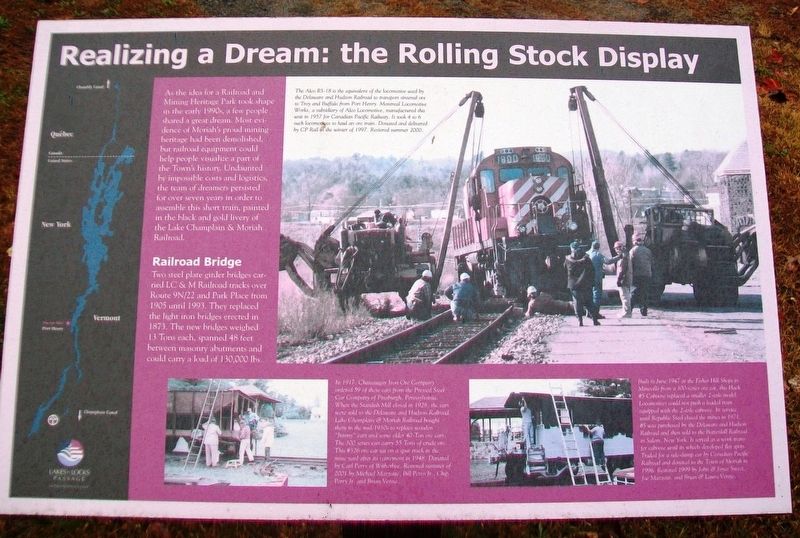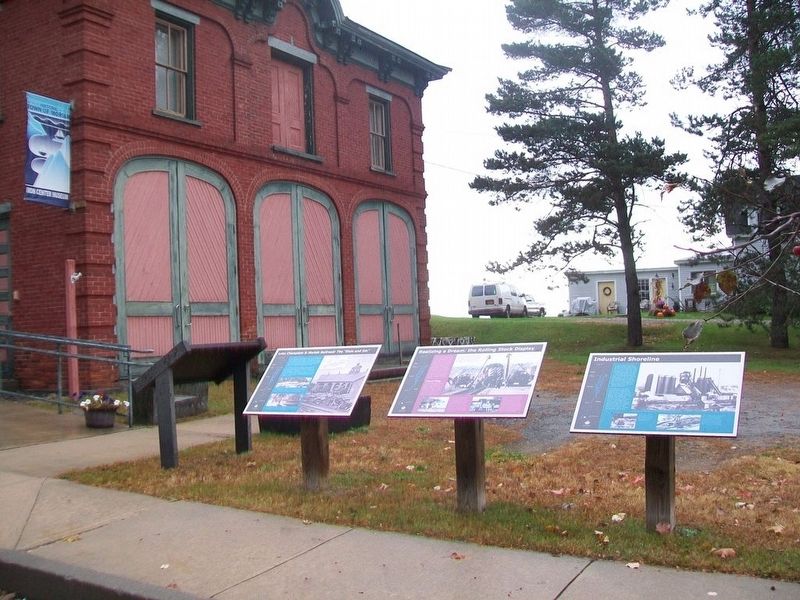Realizing a Dream: the Rolling Stock Display
As the idea for a Railroad and Mining Heritage Park took shape in the early 1990s, a few people shared a great dream. Most evidence of Moriah's proud mining heritage had been demolished, but railroad equipment could help people visualize a part of the Town's history. Undaunted by impossible costs and logistics, the team of dreamers persisted for over seven years in order to assemble this short train, painted in the black and gold livery of the Lake Champlain & Moriah Railroad.
Railroad Bridge
Two steel plate girder bridges carried LC & M Railroad tracks over Route 9N/22 and Park Place from 1905 until 1993. They replaced the light iron bridges erected in 1873. The new bridges weighed 13 Tons each, spanned 48 feet between masonry abutments and could carry a load of 130,000 lbs.
[Photo captions, from left to right, read]
• The Alco RS-18 is the equivalent of the locomotive used by the Delaware and Hudson Railroad to transport sintered ore to Troy and Buffalo from Port Henry. Montreal Locomotive Works, a subsidiary of Alco Locomotive, manufactured this unit in 1957 for Canadian Pacific Railway. It took 4 to 6 such locomotives to haul an ore train. Donated and delivered by CP Rail in the winter of 1997. Restored summer 2000.
• In 1917, Chateaugay Iron Ore Company ordered 59 of these cars from the
Pressed Steel Car Company of Pittsburgh, Pennsylvania. When the Standish Mills closed in 1928, the cars were sold to the Delaware and Hudson Railroad. Lake Champlain & Moriah Railroad bought them in the mid-1930s to replace wooden "Jimmy" cars and some older 40-Ton ore cars. The 300 series can carry 55 Tons of crude ore. This #326 ore car sat on a spur track in the mine yard after its retirement in 1948. Donated by Carl Perry of Witherbee. Restored summer of 2001 by Michael Mazzotte, Bill Petro Jr., Chip Perry Jr. and Brian Venne.
• Built in June 1947 at the Fisher Hill Shops in Mineville from a 300-series ore car, this Hack #5 Caboose replaced a smaller 2-axle model. Locomotives could not push a loaded train equipped with the 2-axle caboose. In service until Republic Steel closed the mines in 1971, #5 was purchased by the Delaware and Hudson Railroad and then sold to the Battenkill Railroad in Salem, New York. It served as a work transfer caboose until its wheels developed flat spots. Traded for a side-dump car by Canadian Pacific Railroad and donated to the Town of Moriah in 1996. Restored 1999 by John & Joyce Sweet, Joe Mazzotti, and Brian & Laura Venne.
Erected by Lakes to Locks Passage.
Topics. This historical marker is listed in these topic lists: Industry & Commerce •
Location. 44° 2.601′ N, 73° 27.476′ W. Marker is in Port Henry, New York, in Essex County. Marker is on Park Place east of Main Street (New York State Route 9N/22), on the left when traveling east. Marker is at the Iron Center Museum. Touch for map. Marker is at or near this postal address: 34 Park Place, Port Henry NY 12974, United States of America. Touch for directions.
Other nearby markers. At least 8 other markers are within walking distance of this marker. Industrial Shoreline (here, next to this marker); Lake Champlain & Moriah Railroad: The "Elsie and Em" (here, next to this marker); A Busy Iron Port (here, next to this marker); The 1929 Lake Champlain Bridge (a few steps from this marker); Veterans Memorial (within shouting distance of this marker); Office Building of Witherbee and Sherman Iron Ore Company (within shouting distance of this marker); Witherbee Park and Town Hall (within shouting distance of this marker); LC&M Caboose (about 400 feet away, measured in a direct line). Touch for a list and map of all markers in Port Henry.
Also see . . . The Iron Center Museum, Port Henry NY. (Submitted on October 17, 2017, by William Fischer, Jr. of Scranton, Pennsylvania.)
Credits. This page was last revised on October 19, 2017. It was originally submitted on October 17, 2017, by William Fischer, Jr. of Scranton, Pennsylvania. This page has been viewed 299 times since then and 14 times this year. Photos: 1, 2. submitted on October 17, 2017, by William Fischer, Jr. of Scranton, Pennsylvania. 3. submitted on October 19, 2017, by William Fischer, Jr. of Scranton, Pennsylvania.


